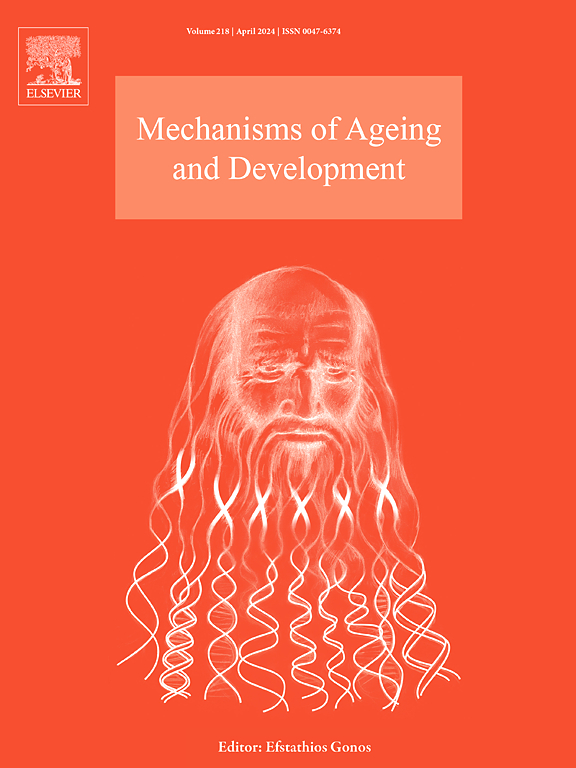The combination of GDF15, FGF21, sRAGE and NfL plasma levels can identify frailty in community-dwelling people across old age
IF 5.1
3区 医学
Q2 CELL BIOLOGY
引用次数: 0
Abstract
Frailty is a complex medical condition characterized by decline in physiological functions and global health of older people, representing a strong risk factor for disability, hospitalization, and mortality. The identification of biomarkers reliably associated with frailty could provide more information on the actual health status and outcome of older subjects. To this aim, we investigated possible associations of four biomarkers related to age and age-related diseases, namely GDF15, FGF21, sRAGE, and NfL, with frailty, measured using frailty index (FI), in community-dwelling subjects of different age. The study was conducted on a cohort of 463 subjects (50–113 years) enrolled before the Covid-19 pandemic and categorized as frail and non-frail, based on a 45-item FI, according to the deficit accumulation model. Plasma levels of the four biomarkers were analysed by Ella Automated ELISA and investigated for their possible association with FI. A Random Forest Decision model was used to assess the biomarkers’ discrimination power with respect to FI. In our cohort, FI was associated with plasma levels of GDF15, NfL and FGF21, but not sRAGE. The first two were also associated with survival. The model based on those four biomarkers estimated frailty with 82 % accuracy. Moreover, frailty estimate obtained with this model led to a more refined prediction of survival on a 3-year follow-up. Our data suggest that GDF15, NfL, FGF21 and sRAGE plasma levels can be proposed as parameters to provide additional information about frailty status and survival with respect to FI in community-dwelling subjects.
结合GDF15、FGF21、sRAGE和NfL血浆水平可以识别老年社区居民的脆弱性
虚弱是一种复杂的医疗状况,其特征是老年人的生理功能和整体健康状况下降,是导致残疾、住院和死亡的一个重要风险因素。鉴定与衰弱可靠相关的生物标志物可以提供有关老年受试者实际健康状况和结果的更多信息。为此,我们研究了与年龄和年龄相关疾病相关的四种生物标志物,即GDF15、FGF21、sRAGE和NfL与虚弱的可能关联,使用虚弱指数(FI)测量,在不同年龄的社区居住受试者中。该研究是在Covid-19大流行之前招募的463名受试者(50-113岁)的队列中进行的,根据赤字积累模型,根据45项FI,将他们分为体弱和非体弱。采用Ella自动化ELISA分析这四种生物标志物的血浆水平,并研究它们与FI的可能关联。随机森林决策模型用于评估生物标志物对FI的辨别能力。在我们的队列中,FI与血浆GDF15、NfL和FGF21水平相关,但与sRAGE无关。前两个也与生存有关。基于这四种生物标志物的模型估计脆弱性的准确率为82% %。此外,使用该模型获得的衰弱估计可以更精确地预测3年随访期间的生存。我们的数据表明,GDF15、NfL、FGF21和sRAGE血浆水平可以作为参数,为社区居住受试者提供有关FI的虚弱状态和生存的额外信息。
本文章由计算机程序翻译,如有差异,请以英文原文为准。
求助全文
约1分钟内获得全文
求助全文
来源期刊
CiteScore
11.10
自引率
1.90%
发文量
79
审稿时长
32 days
期刊介绍:
Mechanisms of Ageing and Development is a multidisciplinary journal aimed at revealing the molecular, biochemical and biological mechanisms that underlie the processes of aging and development in various species as well as of age-associated diseases. Emphasis is placed on investigations that delineate the contribution of macromolecular damage and cytotoxicity, genetic programs, epigenetics and genetic instability, mitochondrial function, alterations of metabolism and innovative anti-aging approaches. For all of the mentioned studies it is necessary to address the underlying mechanisms.
Mechanisms of Ageing and Development publishes original research, review and mini-review articles. The journal also publishes Special Issues that focus on emerging research areas. Special issues may include all types of articles following peered review. Proposals should be sent directly to the Editor-in-Chief.

 求助内容:
求助内容: 应助结果提醒方式:
应助结果提醒方式:


